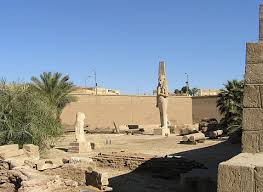Akhmim is the capital of the ninth region of Upper Egypt. In ancient times, it was known as Khent-Min and during the Greek era as Panopolis. It is one of the oldest and most ancient Egyptian cities, with a history spanning over 6,000 years. The city was famous for its linen weaving.
The archaeological site of Akhmim lies beneath the modern city and is one of the most significant locations. The Temple of Ramses II was uncovered here, which according to Herodotus, was surrounded by a stone wall and two massive statues. In 1981, part of the temple and a huge statue of Ramses’ daughter Meritamun were excavated. In 1991, a seated statue of Ramses II was revealed, and the area was turned into an open-air museum, although parts of it remain buried under the modern city buildings.
Die Statue von Meritamun, Sohn von Ramses II. und Königin Nefertari, gilt als die höchste jemals gefundene antike Statue. Sie wurde 1988 wieder zusammengesetzt. Aufgrund ihrer Schönheit ist sie als „Brautstatue“ bekannt. Sie besteht aus Kalkstein und weist noch immer Farbspuren in Rot, Blau, Schwarz, Gelb und Braun auf. Der Künstler betonte Meritamuns Gesichtszüge und formte große Augen, eine spitze Nase und ein rundes Kinn. Sie trägt eine Perücke, die hinten mit einem Doppelband zusammengebunden ist, das mit einem Ornament aus zwei Schlangen und einer Doppelkrone verziert ist, sowie eine Choti-Krone auf dem Kopf. Die Statue enthält zwei Schamfedern auf einem runden Sockel, der mit Reihen des Symbols des „Großen Lebens“ und einer Sonnenscheibe verziert ist.
Die Königin ist mit Schmuck geschmückt, darunter Ohrringe, eine Halskette auf der Brust und breite Armbänder an den Armen. Im Jahr 2019 führte das Ministerium für Altertümer ein Restaurierungsprojekt durch, und innerhalb von sechs Monaten gelang es dem Restaurierungsteam, die Statue von Ramses II. neben der Statue seiner Tochter Meritamun wieder aufzustellen.
Diese 1981 entdeckte Statue war in über 70 Teile zerbrochen. Zu den größten Teilen gehörten der Kopf ohne Krone, ein Teil des Halses, Brustkorb, Bauch, das königliche Gewand, ein Teil eines Knies, eine Faust und mehrere Teile der gravierten Rückensäule. Die Statue besteht aus Kalkstein, ist etwa 12 Meter lang und wiegt über 45 Tonnen. Sie zeigt König Ramses II., der mit dem linken Bein nach vorne steht und die übliche königliche Kleidung trägt. Seine Titel sind in die Rückensäule eingraviert.

